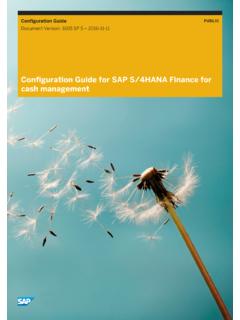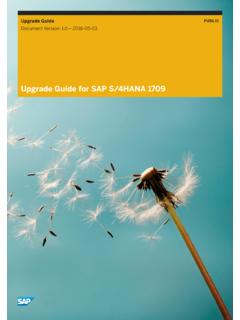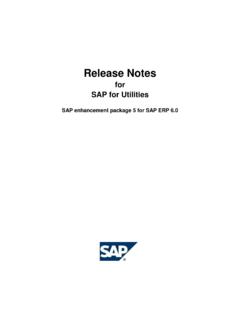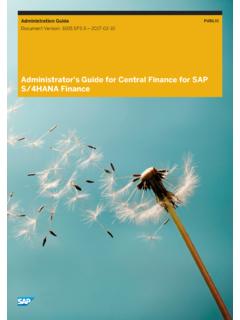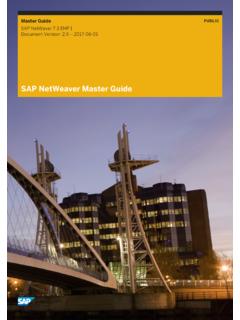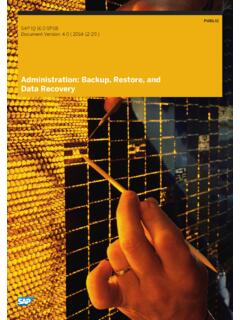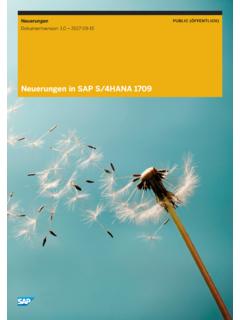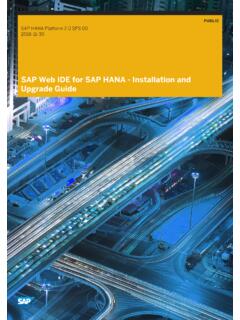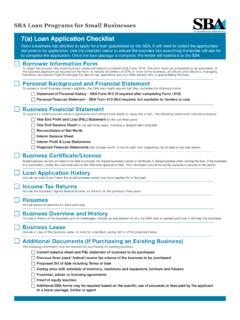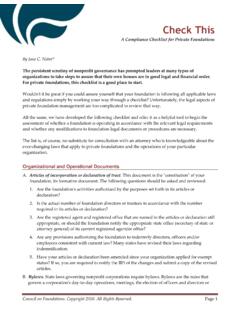Transcription of How to perform a Year-End Closing in SAP Business One
1 How to Guide SAP Business One Document Version: 2022-04-29 PUBLIC How to perform Year-End Closing in SAP Business One All Countries 2 PUBLIC 2022 SAP SE or an SAP affiliate company. All rights reserved. How to perform Year-End Closing in SAP Business One Typographic Conventions Typographic Conventions Type Style Description Example Words or characters quoted from the screen. These include field names, screen titles, pushbuttons labels, menu names, menu paths, and menu options. Textual cross-references to other documents. Example Emphasized words or expressions. EXAMPLE Technical names of system objects. These include report names, program names, transaction codes, table names, and key concepts of a programming language when they are surrounded by body text, for example, SELECT and INCLUDE. Example Output on the screen.
2 This includes file and directory names and their paths, messages, names of variables and parameters, source text, and names of installation, upgrade and database tools. Example Exact user entry. These are words or characters that you enter in the system exactly as they appear in the documentation. <Example> Variable user entry. Angle brackets indicate that you replace these words and characters with appropriate entries to make entries in the system. EXAMPLE Keys on the keyboard, for example, F2 or ENTER. How to perform Year-End Closing in SAP Business One Typographic Conventions PUBLIC 2022 SAP SE or an SAP affiliate company. All rights reserved. 3 Document History Version Date Change 2014-11-26 First version 2021-01-27 Update to Release 2022-04-29 Update section Period-End Closing . 4 PUBLIC 2022 SAP SE or an SAP affiliate company.
3 All rights reserved. How to perform Year-End Closing in SAP Business One Table of Contents Table of Contents Document History .. 3 Quick Guide - Preparation 6 Introduction .. 7 Timing Constraints ..8 Preparation .. 9 Checks 9 Checking the Document Numbering .. 9 Checking the Completeness of Documents .. 10 Checking for Negative Inventory .. 11 Checking for Execution of Payment Runs .. 11 Checking Statistical and Clearing Accounts .. 12 Checking for Completeness of Bank 12 Inventory Count .. 13 Preparing for Inventory Counting .. 13 Posting Count Results ..16 Working with a Non-Perpetual Inventory System ..18 Reclassification of Business Partners and Bank Accounts with Negative Balances ..18 Performing a Year-End Closing .. 21 Changing Period Status to Closing Period .. 21 23 Reconciliation of Internal Reconciliation Upgrade Journals.
4 23 Reconciliation of Open Items and Balances for Business Partners .. 23 Reconciliation of Fixed Asset 26 Reconciliation of Bank Statements and Bank and Cash Accounts .. 26 Reconciliation of Allocation and Expense Clearing Accounts .. 27 Reconciliation of Inventory Accounts .. 29 Inventory Audit Report .. 29 Accrual and Valuation .. 31 Accrual 31 Assets under Construction .. 31 Depreciation in the SAP Business One Fixed Assets .. 32 Valuation of Foreign Currencies .. 32 Material Valuation .. 36 Valuation of Completion of Production Orders and Projects .. 37 Allowances .. 38 Provisions .. 38 Accruals .. 38 How to perform Year-End Closing in SAP Business One Table of Contents PUBLIC 2022 SAP SE or an SAP affiliate company. All rights reserved. 5 Reporting .. 39 VAT Report .. 39 Extended Tax Reporting .. 39 Withholding Tax Report.
5 40 Tax Declaration Box Report .. 40 Tax Reconciliation Report .. 40 EU Sales List .. 41 Bank Reconciliation Report .. 41 Country-Specific 41 Inventory Valuation Simulation Report .. 41 Country-Specific 41 Documentation .. 43 Balance Sheet .. 43 Profit and Loss Statement .. 44 Trial Balance .. 44 Other Reports .. 45 Journal 45 Account Itemization for Balance Sheet and P&L .. 45 Account Statement List for Customers and Vendors ..46 Open Items List and Aging Reports ..46 Account Statements ..46 Asset History Sheet ..46 Inventory Listing .. 47 Valuation According to Other Accounting Principles .. 47 Periods .. 48 Restarting Document Numbering .. 48 Creating New Periods ..49 Using Period 13 ..49 Fiscal year Change in Fixed Assets ..50 Period-End Closing ..50 Country-Specific Feature .. 52 Electronic Annual financial Statement.
6 52 E-Balance: Germany .. 53 Final Closing of the Period .. 53 checklist .. 55 6 PUBLIC 2022 SAP SE or an SAP affiliate company. All rights reserved. How to perform Year-End Closing in SAP Business One Quick Guide - Preparation checklist Quick Guide - Preparation checklist Below are the minimum requirements you must to do to prepare for new financial year : Safeguarding your data Backup database on close of Business on the last trading day of the year . Backup database once all transactions have been entered. Due date for posting period Example: you receive an AP Invoice in December 2021 which is due in January 2022. To be able to post this you need to ensure that under Administration > System Initialization > Posting Periods; the Due Date To is end of January 2022. The field Due Date To can be extended when creating new Posting Periods.
7 This will then apply to all new periods. If the posting periods have already been generated, then you can set the Due Date To individually. New posting periods Create new posting periods in advance at least few weeks before the required time Ensure the posting periods are created in accordance with the requirements - the same way as the previous one. Should the definition vary; this can cause difficulties in comparison reports. Once the first posting has been entered into the new period, can this no longer be deleted or changed. Subsequent periods without any postings can be changed. Advanced GL account determination rules If the advanced GL account determination rules were created after the new periods were entered into the system, then these do not exist in the new periods. If the advanced GL account determination rules were created first and after that the new posting periods, then the rules will be carried over to the new period.
8 Account Setup Avoid changing the account structure / account determination during a financial year . Create new financial period indicators if required. Create new numbering series if required How to perform Year-End Closing in SAP Business One Introduction PUBLIC 2022 SAP SE or an SAP affiliate company. All rights reserved. 7 Introduction This document provides customers and partners with help in carrying out their Year-End Closing and demonstrates how SAP Business One can support the individual steps of the Year-End Closing process. Caution The procedures described in this document do not guarantee the accuracy of the content or the completeness of the Year-End Closing . You are responsible for carrying out all the appropriate operations and providing the appropriate documentation to ensure accuracy. You must discuss the process in detail with your tax consultant or the person responsible for your Year-End Closing .
9 The document presents general concepts that you apply to your specific situation. The character of this document is generic and globally based on the system procedures. Country-specific regulations and other financial reporting principles are not covered. Note SAP Business One provides the ability to identify local and IFRS accounts, enabling the creation of local and IFRS financial statements for compliance reporting. Some SAP Business One functions and features cannot be automatically compliant with IFRS; therefore, adjustments have to be made for some localizations. For more information about IFRS, see the following documents. o SAP Business One in an IFRS Environment o How to Handle Accounting for Leases according to IFRS in & higher o How to perform Parallel Accounting in and higher o How to Recognize Revenue according to IFRS in & higher Note For a collection of information about product details regarding the Year-End Closing process, see SAP Note 800291.
10 This note also provides information about additional queries and tools available for the Year-End Closing process. The screen shots and paths referenced in this document are based on the US localization and SAP Business One release Note There is a Remote Support Platform (RSP) task for Year-End Closing , for more information click here. 8 PUBLIC 2022 SAP SE or an SAP affiliate company. All rights reserved. How to perform Year-End Closing in SAP Business One Timing Constraints Timing Constraints It is not always possible to reconstruct a report backdated to the cut-off date in SAP Business One. Therefore, we strongly recommend that once you have entered and completed all transactions for the previous fiscal year , and before entering any transactions for the new fiscal year , you back up your productive database. The backup saves the status of the previous fiscal year .
